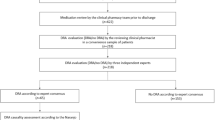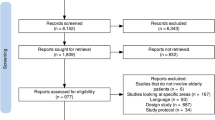Abstract
Background
Adverse drug reactions (ADRs) in older people are often preventable, indicating that screening and prevention programs aimed at reducing their rate are needed in this population.
Objective
The aim of this study was to externally validate the GerontoNet ADR risk score and to assess its validity in specific subpopulations of older inpatients.
Methods
Data from the prospective CRIteria to assess appropriate Medication use among Elderly complex patients (CRIME) cohort were used. Dose-dependent and predictable ADRs were classified as type A, probable or definite ADRs were defined according to the Naranjo algorithm, and diagnostic accuracy was tested using receiver operating characteristic (ROC) analyses. Sensitivity and specificity were calculated for a cut-off point of 4.
Results
The mean age of the 1075 patients was 81.4 years (standard deviation 7.4) and the median number of drugs was 10 (range 7–13). At least one ADR was observed in 70 patients (6.5%); ADRs were classified as type A in 50 patients (4.7%) and defined as probable or definite in 41 patients (3.8%). Fair diagnostic accuracy to predict both type A and probable or definite ADRs was found in subpopulations aged <70 or ≥80 years with heart failure, diabetes, or a previous ADR. Good accuracy to predict type A ADRs was found in patients with a low body mass index (BMI; >18.5 kg/m2) and a Mini-Mental State Examination (MMSE) score of >24/30 points, as well as in patients with osteoarthritis. The cut-off point of 4 points yielded very good sensitivity but poor specificity results in these subpopulations.
Conclusion
This study suggests that the GerontoNet ADR risk score might represent a pragmatic approach to identifying specific subpopulations of older inpatients at increased risk of an ADR with a fair to good diagnostic accuracy.
Similar content being viewed by others
References
Lazarou J, Pomeranz B, Corey P. Incidence of adverse drug reactions in hospitalized patients: a meta-analysis of prospective studies. JAMA. 1998;279:1200–5.
Chan M, Nicklason F, Vial J. Adverse drug events as a cause of hospital admission in the elderly. Intern Med J. 2001;31:199–205.
Khan L. Comparative epidemiology of hospital-acquired adverse drug reactions in adults and children and their impact on cost and hospital stay: a systematic review. Eur J Clin Pharmacol. 2013;69:1985–96.
Stevenson J, Williams J, Burnham T, et al. Predicting adverse drug reactions in older adults: a systematic review of the risk prediction models. Clin Interv Aging. 2014;9:1581–93.
Lavan A, Gallagher P. Predicting risk of adverse drug reactions in older adults. Ther Adv Drug Saf. 2016;7:11–22.
Onder G, Petrovic M, Tangiisuran B, et al. Development and validation of a score to assess risk of adverse drug reactions among in-hospital patients 65 years or older. Arch Intern Med. 2010;170:1142–8.
O’Connor M, Gallagher P, Byrne S, et al. Adverse drug reactions in older patients during hospitalisation: are they predictable? Age Ageing. 2012;41:771–6.
Tosato M, Landi F, Martone A, et al. Potentially inappropriate drug use among hospitalised older adults: results from the CRIME study. Age Ageing. 2014;43:767–73.
WHO Collaborating Centre for Drug Statistics Methodology. Structure and principles. http://www.whocc.no/atc/structure_and_principles/. Accessed 19 Nov 2016.
Folstein M, Folstein S, McHugh P. “Mini-mental state”. A practical method for grading the cognitive state of patients for the clinician. J Psychiatr Res. 1975;12:189–98.
World Health Organization. International drug monitoring: the role of the hospital. WHO Technical Report Series No. 425. Geneva: WHO; 1986.
Naranjo C, Busto U, Sellers E, et al. A method for estimating the probability of adverse drug reactions. Clin Pharmacol Ther. 1981;30:239–45.
National Kidney Foundation. K/DOQI clinical practice guidelines for chronic kidney disease: evaluation, classification, and stratification. Am J Kidney Dis. 2002;39:S1–266.
McElnay J, McCallion C, Al-Deagi F, et al. Development of a risk model for adverse drug events in the elderly. Clin Drug Invest. 1997;13:47–55.
Trivalle C, Burlaud A, Ducimetière P. Risk factors for adverse drug events in hospitalized elderly patients: a geriatric score. Eur Geriatr Med. 2011;2:284–9.
Tangiisuran B, Scutt G, Stevenson J, et al. Development and validation of a risk model for predicting adverse drug reactions in older people during hospital stay: Brighton Adverse Drug Reactions Risk (BADRI) model. PLoS One. 2014;9:1–9.
Petrovic M, van der Cammen T, Onder G. Adverse drug reaction in older people: detection and prevention. Drugs Aging. 2012;29:453–62.
Hutchinson L, O’Brien C. Changes in pharmacokinetics and pharmacodynamics in the elderly patient. J Pharm Pract. 2007;20:4–12.
Mangoni A. Predicting and detecting adverse drug reactions in old age: challenges and opportunities. Expert Opin Drug Metab Toxicol. 2012;8:527–30.
Routledge P, O’Mahony M, Woodhouse K. Adverse drug reactions in elderly patients. Br J Clin Pharmacol. 2004;57:121–6.
Zhang M, Holman C, Preen D, et al. Repeat adverse drug reactions causing hospitalisations in older Australians: a population based longitudinal study 1980-2003. Br J Clin Pharmacol. 2007;63:163–70.
Davies E, Green C, Taylor S, et al. Adverse drug reactions in hospital in-patients: a prospective analysis of 3695 patient-episodes. PLoS One. 2009;4:e4439.
O’Mahony D, Cherubini A, Petrovic M. Optimizing pharmacotherapy in older patients: a European perspective. Drugs Aging. 2012;29:423–5.
National Institute on Aging, National Institutes of Health, US Department of Health and Human Services. Global health and aging. http://www.who.int/ageing/publications/global_health.pdf. Accessed 19 Nov 2016.
Lu Y, Hernandez P, Abegunde D, Edejer T. The world medicines situation 2011: Medicine expenditures. http://www.who.int/health-accounts/documentation/world_medicine_situation.pdf. Accessed 19 Nov 2016.
Acknowledgements
The authors are indebted to Dr. Stefanie De Buyser for her skilful assistance with data analysis.
Author information
Authors and Affiliations
Corresponding author
Ethics declarations
Funding
This work was supported by the Ministry of Labour, Health and Social Policy, who funded the CRIME project (Bando Giovani Ricercatori 2007, convenzione no. 4).
Conflicts of interest
Mirko Petrovic, Balamurugan Tangiisuran, Chakravarthi Rajkumar, Tischa van der Cammen and Graziano Onder declare that they have no conflicts of interest directly relevant to the content of this study.
Rights and permissions
About this article
Cite this article
Petrovic, M., Tangiisuran, B., Rajkumar, C. et al. Predicting the Risk of Adverse Drug Reactions in Older Inpatients: External Validation of the GerontoNet ADR Risk Score Using the CRIME Cohort. Drugs Aging 34, 135–142 (2017). https://doi.org/10.1007/s40266-016-0428-4
Published:
Issue Date:
DOI: https://doi.org/10.1007/s40266-016-0428-4




